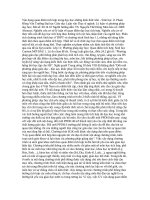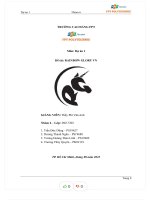a0016 programming lin morebook vn 7712
Bạn đang xem bản rút gọn của tài liệu. Xem và tải ngay bản đầy đủ của tài liệu tại đây (3.45 MB, 7 trang )
Foreword by Luca Bolognese
LINQ Principal Program Manager, Microsoft Corporation
Programming
Microsoft
®
LINQ
Paolo Pialorsi
Marco Russo
Chapter 6
Tools for LINQ to SQL
The best way to write queries using LINQ to SQL is by having a DataContext-derived class
in your code that exposes all the tables, stored procedures, and user-defined functions you
need as properties of a class instance. You also need entity classes that are mapped to the database objects. As you have seen in previous chapters, this mapping can be made by using
attributes to decorate classes or through an external XML mapping file. However, writing this
information by hand is tedious and error-prone work. You need some tools to help you
accomplish this work.
In this chapter, you will learn about what file types are involved and what tools are available to
automatically generate this information. The .NET 3.5 Software Development Kit (SDK)
includes a command-line tool named SQLMetal. Microsoft Visual Studio 2008 offers an integrated graphical tool named the Object Relational Designer. We will examine both tools from
a practical point of view.
Important
In this chapter we use the version of the Northwind database that is included
in the C# samples provided with Visual Studio 2008. All the samples are contained in the
Microsoft Visual Studio 9.0\Samples\1033\CSharpSamples.zip file in your program files directory if you installed Visual Studio 2008. You can also download an updated version of these
samples from />
File Types
There are three types of files involved in LINQ to SQL entities and a mapping definition:
■
Database markup language (.DBML)
■
Source code (C# or Visual Basic)
■
External mapping file (XML)
A common mistake is the confusion between DBML and XML mapping files. At first sight,
these two files are similar, but they are very different in their use and generation process.
DBML—Database Markup Language
The DBML file contains a description of the LINQ to SQL entities in a database markup
language. Visual Studio 2008 installs a DbmlSchema.xsd file, which contains the schema definition of that language and can be used to validate a DBML file. The namespace used for this
187
188
Part II
LINQ to Relational Data
file is which is different from the
namespace used by the XSD for the XML external mapping file.
Note You can find the DbmlSchema.xsd schema file in the %ProgramFiles(x86)%\Microsoft
Visual Studio 9.0\Xml\Schemas folder.
The DBML file can be automatically generated by extracting metadata from an existing
Microsoft SQL Server database. However, the DBML file includes more information than can
be inferred from database tables. For example, settings for synchronization and delayed loading are specific to the intended use of the entity. Moreover, DBML files include information
that is used only by the code generator that generates C# or Visual Basic source code, such as
the base class and namespace for generated entity classes. Listing 6-1 shows an excerpt from
a sample DBML file.
Listing 6-1 Excerpt from a sample DBML file
<?xml version="1.0" encoding="utf-8"?>
SettingsObjectName="DevLeap.Linq.LinqToSql.Properties.Settings"
SettingsPropertyName="NorthwindConnectionString"
Provider="System.Data.SqlClient" />
<Table Name="dbo.Orders" Member="Orders">
<Type Name="Order">
IsDbGenerated="true" CanBeNull="false" />
...
IsForeignKey="true" />
</Type>
</Table>
...
</Database>
The DBML file is the richest container of metadata information for LINQ to SQL. Usually, it
can be generated from a SQL Server database and then manually modified, adding information that cannot be inferred from the database. This is the typical approach when using the
SQLMetal command-line tool. The Object Relational Designer included in Visual Studio 2008
Chapter 6
Tools for LINQ to SQL
189
offers a more dynamic way of editing this file, because programmers can import entities from
a database and modify them directly in the DBML file through a graphical editor. The DBML
generated by SQLMetal can also be edited with the Object Relational Designer.
The DBML file can be used to generate C# or Visual Basic source code for entities and
DataContext-derived classes. Optionally, it can also be used to generate an external XML
mapping file.
More Info It is beyond the scope of this book to provide a detailed description of the
DBML syntax. You can find more information and the whole DbmlSchema.xsd content in the
product documentation at />
C# and Visual Basic Source Code
The source code written in C#, Visual Basic, or any other .NET language contains the definition of LINQ to SQL entity classes. This code can be decorated with attributes that define the
mapping of entities and their properties with database tables and their columns. Otherwise,
the mapping can be defined by an external XML mapping file. However, a mix of both is not
allowed—you have to choose only one place where the mappings of an entity are defined.
This source code can be automatically generated by tools such as SQLMetal directly from a
SQL Server database. The code-generation function of SQLMetal can translate a DBML file to
C# or Visual Basic source code. When you ask SQLMetal to directly generate the source code
for entities, internally it generates the DBML file that is converted to the entity source code. In
Listing 6-2, you can see an excerpt of the C# source code generated for LINQ to SQL entities
that were generated from the DBML sample shown in Listing 6-1.
Listing 6-2 Excerpt from the class entity source code in C#
[System.Data.Linq.Mapping.DatabaseAttribute(Name="Northwind")]
public partial class nwDataContext : System.Data.Linq.DataContext {
// ...
public System.Data.Linq.Table<Order> Orders {
get { return this.GetTable<Order>(); }
}
}
[Table(Name="dbo.Orders")]
public partial class Order : INotifyPropertyChanging, INotifyPropertyChanged {
private int _OrderID;
private string _CustomerID;
private System.Nullable<System.DateTime> _OrderDate;
[Column(Storage="_OrderID", AutoSync=AutoSync.OnInsert,
DbType="Int NOT NULL IDENTITY", IsPrimaryKey=true,
IsDbGenerated=true)]
190
Part II
LINQ to Relational Data
public int OrderID {
get { return this._OrderID; }
set {
if ((this._OrderID != value)) {
this.OnOrderIDChanging(value);
this.SendPropertyChanging();
this._OrderID = value;
this.SendPropertyChanged("OrderID");
this.OnOrderIDChanged();
}
}
}
[Column(Storage="_CustomerID", DbType="NChar(5)")]
public string CustomerID {
get { return this._CustomerID; }
set {
if ((this._CustomerID != value)) {
if (this._Customer.HasLoadedOrAssignedValue) {
throw new ForeignKeyReferenceAlreadyHasValueException();
}
this.OnCustomerIDChanging(value);
this.SendPropertyChanging();
this._CustomerID = value;
this.SendPropertyChanged("CustomerID");
this.OnCustomerIDChanged();
}
}
}
[Column(Storage="_OrderDate", DbType="DateTime")]
public System.Nullable<System.DateTime> OrderDate {
get { return this._OrderDate; }
set {
if ((this._OrderDate != value)) {
this.OnOrderDateChanging(value);
this.SendPropertyChanging();
this._OrderDate = value;
this.SendPropertyChanged("OrderDate");
this.OnOrderDateChanged();
}
}
}
[Association(Name="Customer_Order", Storage="_Customer",
ThisKey="CustomerID", IsForeignKey=true)]
public Customer Customer {
get { return this._Customer.Entity; }
set {
Customer previousValue = this._Customer.Entity;
if ((previousValue != value)
|| (this._Customer.HasLoadedOrAssignedValue == false)) {
this.SendPropertyChanging();
494
Part V
Applied LINQ
Summary
This chapter showed you how to leverage the new features and controls available in ASP.NET 3.5
to develop data-enabled Web applications, using LINQ to SQL and LINQ in general.
Consider that what you have seen is really useful for rapidly defining Web site prototypes and
simple Web solutions. On the other hand, in enterprise-level solutions you will probably
need at least one intermediate layer between the ASP.NET presentation layer and the data
persistence one, represented by LINQ to SQL. In real enterprise solutions, you usually also
need a business layer that abstracts all business logic, security policies, and validation rules
from any kind of specific persistence layer. And you will probably have a Model-View-Controller
or Model-View-Presenter pattern governing the UI. In this more complex scenario, chances
are that the LinqDataSource control will be tied to entities collections more often than to LINQ
to SQL results.
Programming Microsoft LINQ
®
Dig into LINQ—and transform the way you work
with data.
With LINQ, you can query data—no matter what the source—
directly from Microsoft Visual Basic® or C#. Guided by two
data-access experts who’ve worked in depth with LINQ and the
Microsoft development teams, you’ll learn how Microsoft .NET
Framework 3.5 implements LINQ, and how to exploit it. Study
and adapt the book’s examples—and deliver your own solutions
faster and with leaner code.
Discover how to:
• Transcend data boundaries using LINQ’s unified syntax
• Query relational databases with LINQ to SQL—and dynamically
manage tables, views, and stored procedures
• Read, write, and manage XML content more efficiently with
About the Authors
Paolo Pialorsi is a consultant, trainer, and
author who specializes in developing solutions
with Microsoft .NET, XML, and Web services.
He has written four books and speaks at
industry conferences.
Marco Russo trains and consults with
professional developers working with the
.NET Framework and Microsoft SQL Server®.
He’s active in developer communities and
blogs, and has written three books.
The authors are founders of DevLeap, a firm
dedicated to educating and mentoring the
professional developer community.
LINQ to XML
• Explore how LINQ works with Windows Communication
đ
Foundation, Windows Presentation Foundation, Microsoft
Silverlight, and ASP.NET
ã Review best practices for data-enabled Web applications
and service development
• Extend LINQ—creating custom operators and providers
• Get a preview of Parallel LINQ (PLINQ) and LINQ to Entities
Get code samples on the Web
For system requirements, see the Introduction.
R E S O U R C E R OA D M A P
Developer Step by Step
• Hands-on tutorial covering
fundamental techniques and features
• Practice files on CD
• Prepares and informs new-to-topic
programmers
Developer Reference
• Expert coverage of core topics
• Extensive, pragmatic coding examples
• Builds professional-level proficiency
with a Microsoft technology
Focused Topics
• Deep coverage of advanced
techniques and capabilities
• Extensive, adaptable coding examples
• Promotes full mastery of a
Microsoft technology
Part No. X14-71508
See inside cover for more information
ISBN-13: 978-0-7356-2400-9
ISBN-10: 0-7356-2400-3
90000
U.S.A. $49.99
[Recommended]
9
780735 624009
Programming/
Microsoft Visual Studio/LINQ









